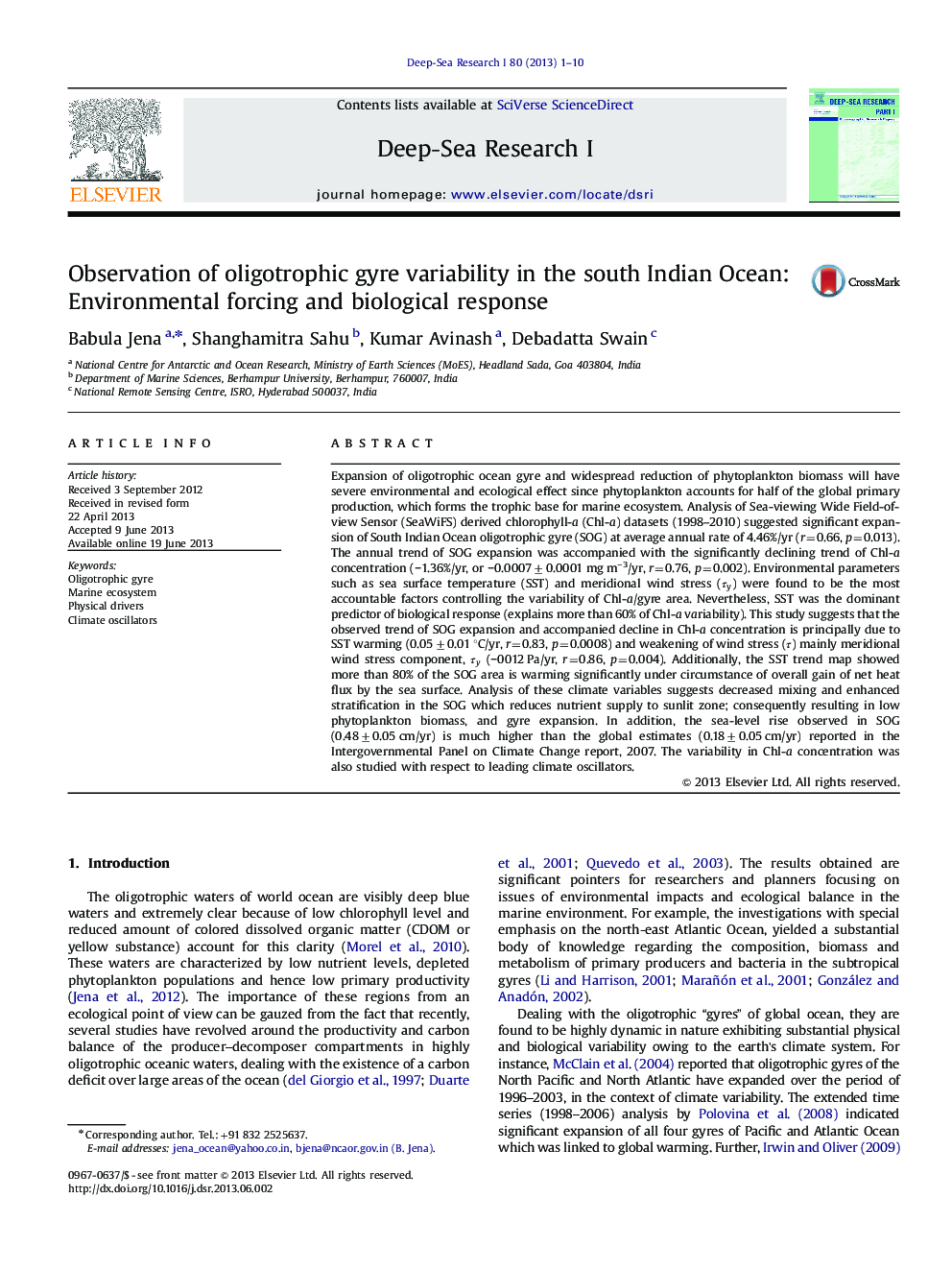| کد مقاله | کد نشریه | سال انتشار | مقاله انگلیسی | نسخه تمام متن |
|---|---|---|---|---|
| 4534563 | 1626350 | 2013 | 10 صفحه PDF | دانلود رایگان |

• Comprehensive study to characterize the SOG and to detect significant expansion of SOG area (4.46%/yr) with rapid rate during 2006–2010.
• Observed widespread significant declining trend of SOG Chl-a (−1.36%/yr).
• SST and τyτy were the most accountable factors controlling the variability of SOG Chl-a. SST explains more than 60% of Chl-a variability.
• ∼80% of SOG area is warming (p<0.05). Decreased mixing and enhanced stratification reduced nutrient supply to SOG sunlit zone resulted in low Chl-a.
• Sea-level rise (0.48±0.05 cm/yr) in SOG is much higher than the global estimates (0.18±0.05 cm/yr).
Expansion of oligotrophic ocean gyre and widespread reduction of phytoplankton biomass will have severe environmental and ecological effect since phytoplankton accounts for half of the global primary production, which forms the trophic base for marine ecosystem. Analysis of Sea-viewing Wide Field-of-view Sensor (SeaWiFS) derived chlorophyll-a (Chl-a) datasets (1998–2010) suggested significant expansion of South Indian Ocean oligotrophic gyre (SOG) at average annual rate of 4.46%/yr (r=0.66, p=0.013). The annual trend of SOG expansion was accompanied with the significantly declining trend of Chl-a concentration (−1.36%/yr, or −0.0007±0.0001 mg m−3/yr, r=0.76, p =0.002). Environmental parameters such as sea surface temperature (SST) and meridional wind stress (τyτy) were found to be the most accountable factors controlling the variability of Chl-a/gyre area. Nevertheless, SST was the dominant predictor of biological response (explains more than 60% of Chl-a variability). This study suggests that the observed trend of SOG expansion and accompanied decline in Chl-a concentration is principally due to SST warming (0.05±0.01 °C/yr, r=0.83, p =0.0008) and weakening of wind stress (ττ) mainly meridional wind stress component, τyτy (−0012 Pa/yr, r=0.86, p=0.004). Additionally, the SST trend map showed more than 80% of the SOG area is warming significantly under circumstance of overall gain of net heat flux by the sea surface. Analysis of these climate variables suggests decreased mixing and enhanced stratification in the SOG which reduces nutrient supply to sunlit zone; consequently resulting in low phytoplankton biomass, and gyre expansion. In addition, the sea-level rise observed in SOG (0.48±0.05 cm/yr) is much higher than the global estimates (0.18±0.05 cm/yr) reported in the Intergovernmental Panel on Climate Change report, 2007. The variability in Chl-a concentration was also studied with respect to leading climate oscillators.
South Indian Ocean Oligotrophic gyre (SOG) as seen from SeaWiFS chlorophyll-a (Chl-a) composite image (1998–2010). The major circulation patterns (dashed lines) were interpreted using earlier work ( Stramma, 1992, Godfrey et al., 2001, Gordon et al., 2003, Povinec et al., 2011 and Jena et al., 2012). SEC–South Equatorial Current; ITF–Indonesian throughflow; AC–Agulhas Current; ARC–Agulhas Return Current; SIOC–South Indian Ocean Current; WAC–West Australian Current; LC–Leeuwin Current. Locations of various climatological southern ocean fronts are represented as solid lines (Orsi et al., 1995). In situ Chl-a observations obtained from R/V Kaimimoana cruise (squares) and R.V. Mirai cruise -MR 03-K04-leg5 (circles). (b) Latitude-vertical section of Chl-a along 80°E observed during R/V Kaimimoana cruise, 5–13, October 1995, confirmed the oligotrophic characteristics of the gyre having 0.05 mg/m3 Chl-a contours extending up to a depth of 50–60 m. (c) The SOG extent (dashed polygon) and drifter-based near-surface current vector (arrows) climatology superimposed on sea surface temperature image. (d) Upper panel showing anti-clockwise current flow pattern ‘V’ around the gyre when the inward Ekman transport due to the Coriolis force (Fc) is balanced by the outward force due to gravity, e.g. (Madl, 2000). Middle and lower panel showing cross section of the zonally averaged (65–00°E) annual temperature and salinity field based on World Ocean Atlas, 2009. The zone between two dashed lines shows the structure of SOG. The depressed thermocline/halocline is due to downwelling process resulted from convergence of water masses at the gyre center (upper panel). The sub-surface (∼400 m to ∼1000 m) temperature (T)/salinity (S) structure of the SOG is ventilated by denser water from the Sub-Antarctic Mode Water (SAMW) ( Tsubouchi et al., 2010 and Koch-Larrouy et al., 2010). The T/S structure between ∼1000 m to ∼1500 m is ventilated by dense Antarctic Intermediate Water (AAIW) sourced from polar frontal zone (PFZ) (You, 1998).Figure optionsDownload as PowerPoint slide
Journal: Deep Sea Research Part I: Oceanographic Research Papers - Volume 80, October 2013, Pages 1–10